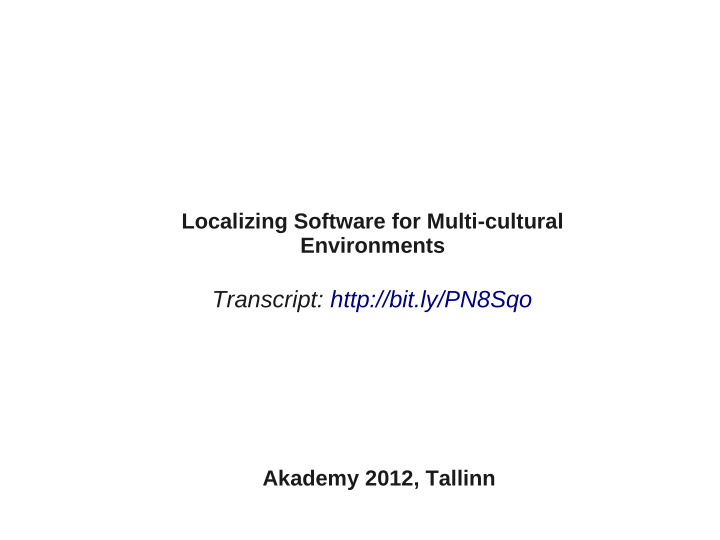



Localizing Software for Multi-cultural Environments Transcript: http://bit.ly/PN8Sqo Akademy 2012, Tallinn
about me: ● Runa Bhattacharjee [ runab@fedoraproject.org , IRC: arrbee] ● Live in Pune, India ● Work on various things related to Localization ● History with KDE – Bengali India translation and mentoring ● Leisure activity – “reverse engineering on the culinary front”
- Localization Can have Hidden Challenges + Known Experiences can solve them
A = People comfortable in using new technology B = People compelled to use new technology C = Potential Survivors We owe to the progress that we are imposing on our lives
About This Talk
In Theory: A = Country B, C, D, E, F, G, H, I = States divided based upon language
In Practice : A = Country B, C, D, E, F, G, H, I = States divided based upon language
A = Country 1 B = Country 2 B, C, D = Individual Geographical locations speaking the same language
Complexities
People Language Favourite Home Cooked Meal Matters of Habit
Proverb 1: do do kos mein zuban badal jaati hain i.e. the dialect in this land changes in every 2 kos (about 25 miles) Proverb 2: ek desher buli onyo desher gaali i.e. harmless words in one language maybe offensive when used in another language
ONE SIZE FITS ALL SOLUTION
ONE SIZE FITS ALL SOLUTION
TERMINOLOGY -> IDEAL?
TERMINOLOGY -> IDEAL? SUITED TO QUICKLY CHANGE
TAKA – টাকা - Bengali word for currency INDIA – INDIAN CURRENCY RUPEE (in Bengali speaking areas), Symbol ₹ BANGLADESH – BANGLADESHI CURRENCY TAKA, Symbol ৳
Non multi-cultural Geopolitical boundary
HOMEGENEOUS TERMINOLOGY
Terminology Help Translator Comments Collaboration in Descriptions & WORKAROUNDS Translation Interpretations Reference from Similar Languages Take aways: Ready reckoners without redoing research
Comments Query systems Tools for Referencing WORKAROUNDS Collaboration Take aways: Cross-referencing tools
Pingbacks to original content creator Simplify Source Original content WORKAROUNDS Content writers to be aware of the ‘translate-ability’ of the terms they use Take away: Functional Content
Interface content generators Dynamic Easy input WORKAROUNDS Translation method systems Take away: Requirement dependent scaling
Basic functionalities Standardise Pre-defined and WORKAROUNDS some content shared content Layered guidelines for eventual standardization Take away: Preserve and use defined content
Existing Examples Learn from Case From Similar WORKAROUNDS Studies languages Take away: If it has been done before, it can be done again
Conclusion
my questions : 1. Has a one language environment helped in Localization? 2. How did you work on achieving standardized localized content? .... discussions
Jellyfish photo credit: http://www.flickr.com/photos/mfajardo/399908384/
my questions : 1. Has a one language environment helped in Localization? 2. How did you work on achieving standardized localized content?
Recommend
More recommend